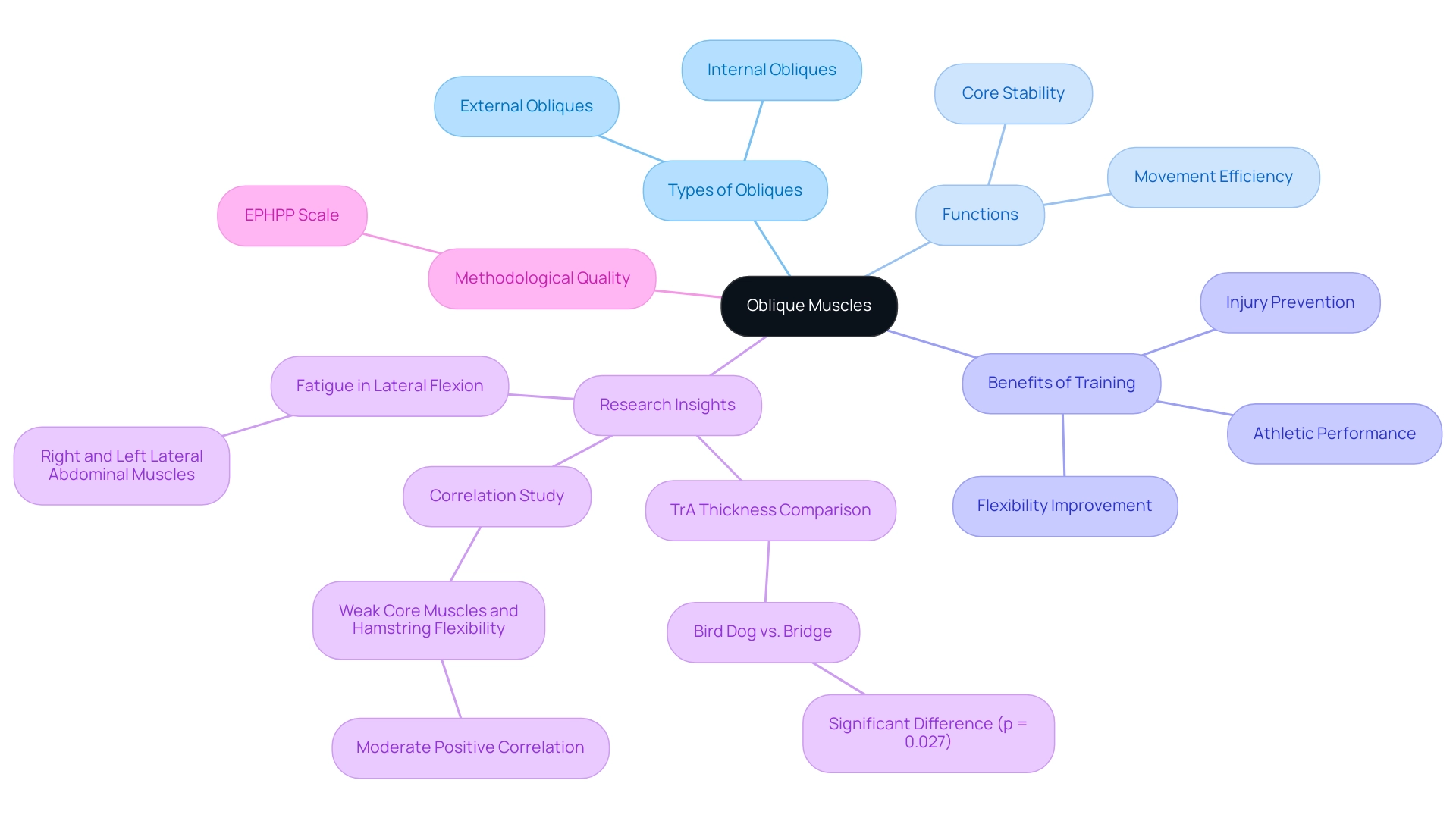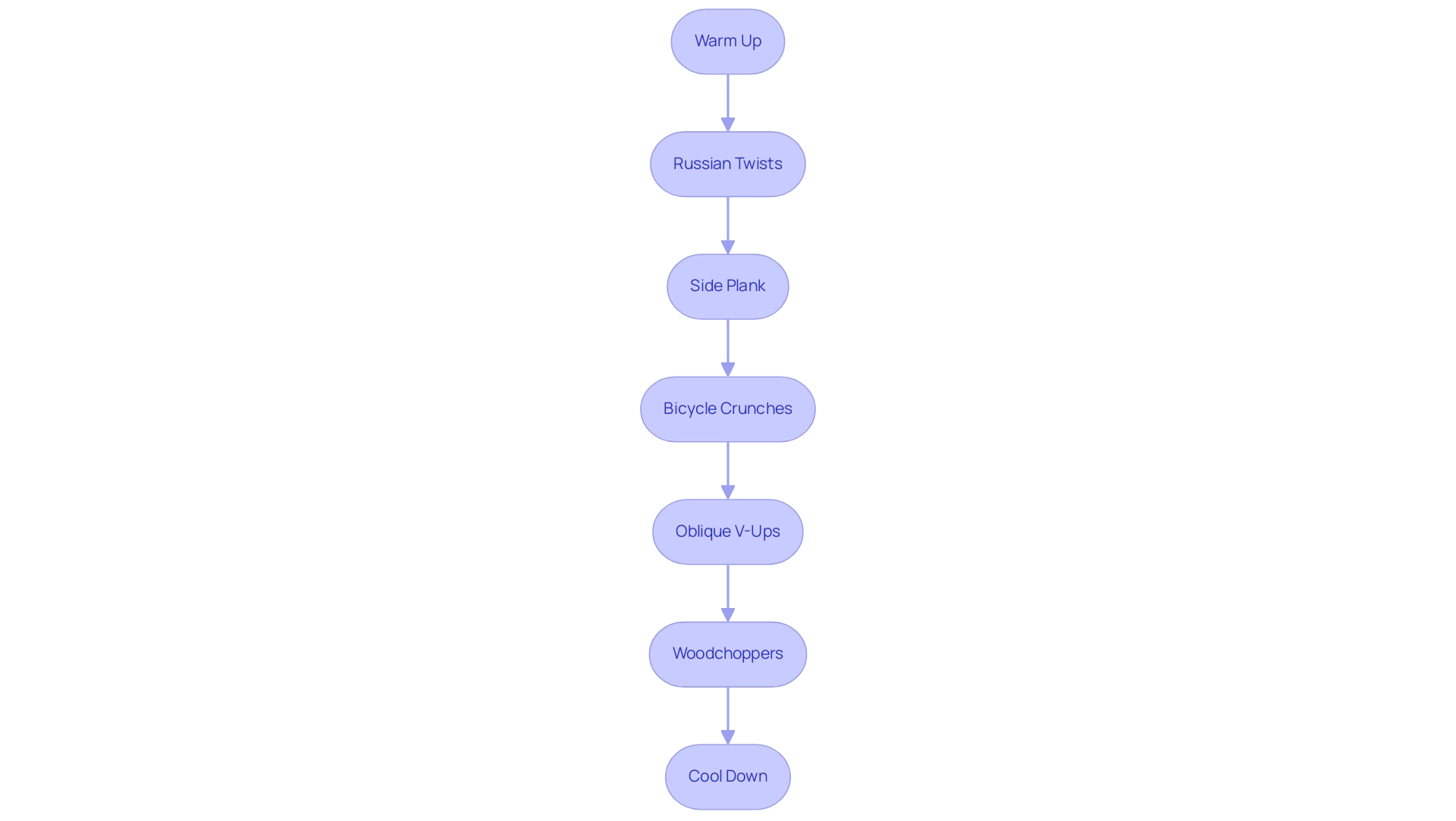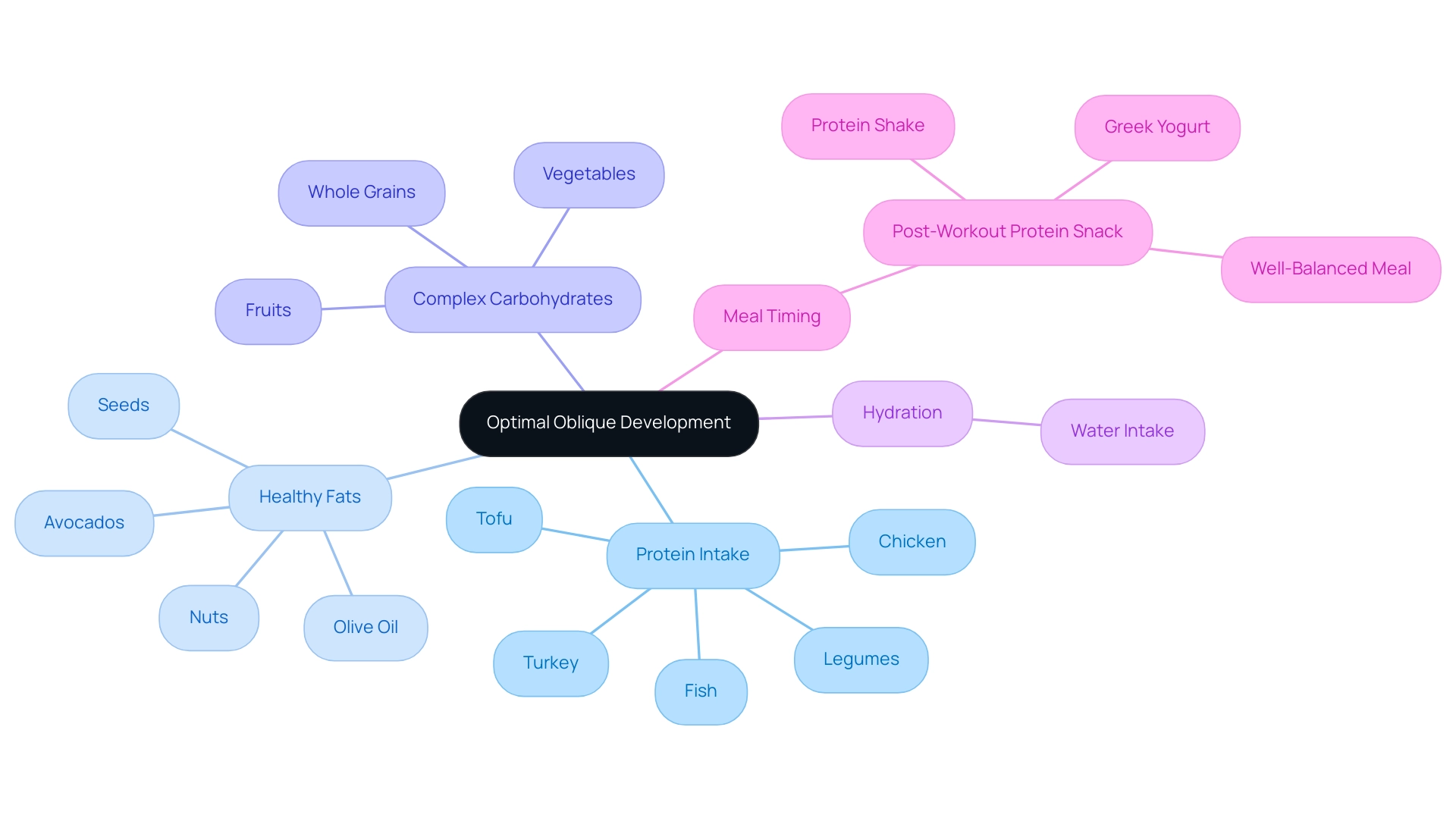Overview
To achieve wide obliques, it is essential to follow a targeted workout routine that includes exercises like Russian twists, side planks, and woodchoppers, which effectively engage and strengthen the oblique muscles. The article supports this by detailing a step-by-step guide that emphasizes proper form and consistency, highlighting the importance of these exercises in enhancing core stability and overall athletic performance.
Introduction
In the pursuit of fitness and well-being, the oblique muscles often remain an overlooked component of core strength. Nestled on the sides of the abdomen, these muscles play a pivotal role not only in aesthetics but also in enhancing athletic performance and stability. A well-developed set of obliques can lead to improved balance, better posture, and reduced risk of injury, making them essential for anyone serious about their fitness journey.
This article delves into the significance of oblique training, offering a comprehensive workout routine, nutritional guidance, and effective strategies for tracking progress. By prioritizing these elements, individuals can achieve a sculpted midsection while fostering a culture of health and vitality. Embrace the journey to stronger obliques and unlock the full potential of your physical capabilities!
Understanding Oblique Muscles: The Key to a Wider Waist
The slanted fibers, strategically placed on the sides of your abdomen, are essential for core stability and overall movement efficiency. This group of tissues includes the wide obliques, such as the external obliques, prominently visible along the waist, and the internal obliques, which lie beneath them. Strengthening these muscles goes beyond aesthetic benefits; it significantly contributes to improved athletic performance by enhancing balance and stability.
Recent research highlights that targeted workouts can result in significant enhancements in core stability—one investigation observed that the thickness of the transverse abdominis (Tra) during particular activities, such as the bird dog, is considerably greater than during others, emphasizing the efficacy of focused training (p = 0.027). As Ioannis Tsartsapakis from the Laboratory of Neuromechanics emphasizes,
The results indicate that the hollowing maneuver led to a greater increase in the thickness of the Tra, internal muscles, and lumbar multifidus across all seven exercises tested, compared to the bracing maneuver.
Furthermore, a case study has shown a moderate positive correlation between weak core stability and hamstring tightness, suggesting that enhancing core strength can lead to improved flexibility and overall performance.
Furthermore, news reports suggest that the wide obliques, which include the right and left lateral abdominal muscles, undergo considerable fatigue during lateral flexion positions, highlighting the practical significance of side muscle training in real-world contexts. By incorporating targeted angled exercises into your fitness routine, you can develop a more toned and sculpted midsection while simultaneously improving your overall core strength—a crucial factor for athletic excellence and injury prevention. Lastly, the methodological quality of the studies referenced can be assessed using the Effective Public Health Practice Project (EPHPP) scale, lending further credibility to the findings discussed.

Step-by-Step Workout Routine for Targeting Obliques
To effectively target your side muscles, especially the wide obliques, and enhance overall core strength, follow this comprehensive step-by-step workout routine. Each activity should be performed with attention to proper form and control for optimal results:
- Russian Twists: Sit on the floor with your knees bent and lean back slightly. Hold a weight or a medicine ball, twisting your torso to the right and then to the left. Aim for 3 sets of 15-20 repetitions. This activity not only activates the wide obliques but also enhances rotational strength, which is essential for different sports. As emphasized in the case analysis titled 'Enhanced Power Potential,' the Russian twist aids in boosting power capacity during rotational movements by training the wide obliques to generate force.
- Side Plank: Lie on your side, propping your body up on one elbow. Maintain a straight line from head to feet and hold the position for 30-60 seconds on each side. For those who may find this challenging, consider placing the bottom knee on the floor and lifting the top leg to modify the exercise. Focusing on 3 sets will greatly enhance your core stability and side strength, as numerous studies emphasize the engagement of the wide obliques during this period.
- Bicycle Crunches: Lie on your back with your hands behind your head and legs elevated. Bring your right elbow towards your left knee while extending your right leg. Alternate sides for 3 sets of 15-20 repetitions. This dynamic movement effectively engages the wide obliques, enhancing coordination.
- Oblique V-Ups: Lie on your side with your legs straight. Lift your legs and upper body simultaneously, reaching your hand towards your feet. Perform 3 sets of 10-15 repetitions on each side. This activity is excellent for targeting the wide obliques and enhancing their definition.
- Woodchoppers: Stand with your feet shoulder-width apart, holding a weight. Rotate your torso as you bring the weight diagonally from above one shoulder to the opposite hip. Complete 3 sets of 12-15 repetitions on each side. This functional movement mimics real-life activities, making it a practical addition to your routine.
Before starting your workout, remember to warm up adequately and cool down afterward to prevent injuries. As Dr. Angela M. Bell states, 'Here's all you need to know about REDs if you follow a demanding exercise routine, whether as a professional athlete or as an amateur competitor.' Consistency is the cornerstone of success, so aim to incorporate this routine into your weekly fitness plan. In doing so, you’ll not only witness a transformation in your side muscles but also foster a culture of wellness and vitality within your team!

Incorporating Nutrition for Optimal Oblique Development
To achieve optimal development of wide obliques, it’s crucial to adopt a balanced diet that not only supports growth but also facilitates recovery. Research indicates that roughly 5–7% of the young adult population fulfills the diagnostic criteria for metabolic syndrome, emphasizing the significance of proper nutrition in preventing health problems associated with development. Here are essential nutritional tips to consider:
- Protein Intake: Incorporating lean protein sources such as chicken, turkey, fish, legumes, and tofu is vital. Research indicates that exceeding a total protein intake of 1.3 grams per kilogram of body weight per day can significantly enhance lean body mass (LBM) when paired with resistance training. As noted by Everson A Nunes, a Tier 2 Research Productivity Fellow, "Protein is essential for tissue repair and growth, particularly when combined with resistance training." This emphasizes the significance of protein for physical development.
- Healthy Fats: Don't overlook the role of healthy fats from avocados, nuts, seeds, and olive oil. These fats are essential for hormone production and overall health, both of which are crucial for effective physical development.
- Complex Carbohydrates: Fuel your workouts with complex carbohydrates found in whole grains, fruits, and vegetables. These sources provide the necessary energy for intense training sessions and assist in replenishing glycogen stores post-exercise.
- Hydration: Staying adequately hydrated is key. Drinking plenty of water throughout the day not only enhances overall performance but also aids in recovery.
- Meal Timing: Consider the timing of your meals, particularly post-workout. Consuming a protein-rich snack or meal within 30 minutes after exercising can significantly promote muscle recovery and growth—options include a protein shake, Greek yogurt, or a well-balanced meal.
The meta-analysis revealed that total protein intake enhances LBM in a dose-dependent manner, with significant effects observed up to 1.3 g/kg BW/d, beyond which the benefits diminish. By prioritizing these nutritional strategies alongside your training regimen, you can enhance your results and work towards achieving the defined muscle tone, including wide obliques, you aspire to.

Tracking Progress and Staying Motivated
To keep your motivation high and ensure you're on a path to achieving well-defined, wide obliques, consider implementing these effective strategies for tracking your progress:
- Set Clear Goals: Establish specific, measurable objectives for your unconventional training. Aim, for example, to raise the number of repetitions for each activity or establish a goal for how many days per week you will devote to your side muscles. Research indicates that clear goal setting can significantly enhance motivation and adherence to fitness routines.
- Utilize a Fitness Journal: Maintain a fitness journal where you can detail your workouts, including the exercises performed, sets, repetitions, and personal reflections on each session. This documentation not only tracks your progress but also allows you to identify patterns and adapt your training efficiently.
- Take Measurements: Regularly measure your waist and the width of your obliques every few weeks. This tangible evidence of progress serves as a powerful motivator, confirming the effectiveness of your efforts. Notably, a recent research found that 13% of participants skipped a step entirely and moved up two stages in a 10-week period, underscoring the impact of consistent tracking.
- Capture Progress Photos: Take monthly progress photos from various angles. Visual documentation can be a compelling reminder of your journey, helping you appreciate the changes and progress you've made over time.
- Celebrate Milestones: Recognize and celebrate your achievements, whether it's completing a challenging workout or reaching a specific milestone. Rewarding yourself reinforces positive behavior and keeps motivation levels high. This approach is essential, as many participants in fitness research reported common barriers to maintaining routines, such as unclear goals and anxiety about gym environments. A case study titled "Barriers to Keeping Up a Fitness Routine" revealed that many Americans feel intimidated by the gym environment, which can hinder their ability to develop a consistent workout routine. Support systems, including personal celebrations, can help overcome these challenges. Additionally, it’s worth noting that 'the median household income of the average zip code with a gym or studio is $72,720, compared to $56,694 for all zip codes,' highlighting the accessibility issues that can affect motivation.
By embracing these strategies for tracking your progress and celebrating your successes, you will not only maintain motivation but also cultivate a commitment to achieving impressive wide obliques.
![]()
Conclusion
Strengthening the oblique muscles is a transformative journey that yields far-reaching benefits beyond aesthetics. These key muscles play a crucial role in core stability, athletic performance, and injury prevention. By incorporating targeted exercises, individuals can enhance their balance and posture, significantly improving their overall physical capabilities. The workout routine outlined provides a practical framework to engage and develop these essential muscles, ensuring both immediate results and long-term health.
Nutrition is equally vital in this endeavor, as a balanced diet rich in protein, healthy fats, and complex carbohydrates fuels workouts and promotes recovery. Staying hydrated and timing meals effectively can further enhance muscle development, ensuring that the efforts put into training are maximized.
Tracking progress is essential to stay motivated and committed to the fitness journey. Setting clear goals, maintaining a fitness journal, and celebrating milestones can create a sense of accomplishment that reinforces dedication. By embracing these strategies, individuals will not only sculpt their obliques but also foster a culture of health and vitality that benefits their overall well-being. Now is the time to prioritize oblique training and unlock the full potential of your core strength, paving the way for a healthier, more active lifestyle.




